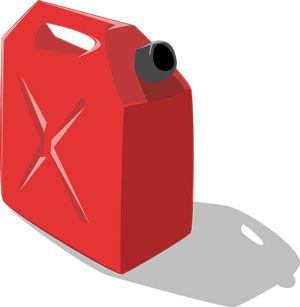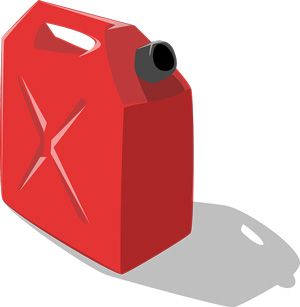How Long Does Gasoline Really Last?

Gasoline is one of those essentials that many preppers will choose to keep on hand as part of their survival stash. Considering it is absolutely essential for powering the vast majority of automobiles, smaller vehicles, generators and power tools this is prudent.
Unfortunately, gasoline presents several challenges for the preppers who would store it for the long haul, namely that it has a notoriously short shelf-life compared to other consumable resources in your inventory. How often do you need to rotate your gasoline? Is there anything you can do to extend the shelf-life? What factors affect its longevity?

Average gasoline you obtain from a gas pump will last anywhere from three to six months depending on its age and ethanol content. Higher ethanol content shortens lifespan, while purer gasoline will last longer. Other factors that can greatly degrade or extend the shelf life of gasoline are the conditions it is stored in, the container that holds it and any additives or contaminants that will improve shelf life, or reduce it respectively.
Understanding these many variables is absolutely essential for making sure your gasoline does not go bad leaving you stranded or out of power when you need it the most.
In the remainder of this article we will go over these variables so you are able to more accurately estimate the shelf life of your gas.
Understanding the Degradation of Gasoline
You can get a surprising amount of shelf life out of gasoline so long as you start with high quality gas, store it correctly and add a few select stabilizers and other chemicals that can boost its lifespan.
But you are right to worry about gasoline getting old or going bad, because over time it loses its combustive property through evaporation of volatile molecules, the infiltration of condensation (meaning water) and also through the separation of the gasoline and ethanol.
Contamination is an issue depending on how it is stored, and what kind of container it is stored in.
Purity
If you know any serious car guys, especially those who drive older, restored vehicles you have likely heard them railing about the addition of ethanol to gasoline. Ethanol is significantly corrosive, which leads to problems with certain engines, but it also reduces the shelf life of gasoline because ethanol readily oxidizes, ruining the gas.
To make matters worse, ethanol also attracts water readily which means any water that was already present in a container (to say nothing of humidity in the air) will contaminate the fuel with water.
As far as shelf-life is concerned, the more ethanol the gas has the shorter the shelf life, whereas little or no ethanol will greatly extend shelf-life.
Most of your common gasoline with ethanol added sold in the United States is what is known as E10, meaning it is 90% gasoline and 10% ethanol. This common blend will last about three months in a correct container stored in ideal conditions, but rarely longer.
Pay attention to the E-rating on your gasoline mixture because E15 or E20 will go bad even faster.
If you care to hunt down pure gasoline you’ll be happy to know that will last for about 6 months when stored under the same conditions. It will still fail due to oxidation in the end, but will do so much more slowly than ethanol-blended gas.
Also pure gasoline is hydrophobic, meaning it actively repels water and will not absorb it hungrily like ethanol blends will. It also does not separate like ethanol-blended gasoline does, making pure gasoline, if you can find it, your hands-down winner for long-term storage and stockpiling!
Storage Container
You always want to store gasoline in a proper container, and if you have any choice in the matter you will be wise to use a plastic gas can that preferably holds no more than 5 gallons.
I know, you can hate on those government-mandated complicated spouts all you want, but plastic has a lot of advantages over traditional and popular metal Jerry cans, namely it will not corrode internally ruining your store gasoline with particles of rust.
You should also make it a point to store your gasoline as near to container capacity as you can to reduce the ratio of gasoline to air volume, and slow condensation.
Where you store your can also makes a difference, as areas of high humidity or temperature changes will promote condensation over an area that is temperature stable.
Fuel Stabilizers
Fuel stabilizers are additives you mix into your gasoline prior to storage in order to slow down the oxidation process and prevent evaporation of those necessary combustive compounds that I mentioned.
Too much of either one and your gasoline will lose efficiency at best or just not work at worst. Lucky for us these fuel stabilizers really do work and are almost a necessity for efficient long-term storage.
Depending on the brand and its capabilities along with the grade of gasoline that you are storing, mixing in the right fuel stabilizer to your gasoline can extend your shelf life all the way up to three years!
That is rightly impressive, and something everyone should get familiar with especially if storing major quantities of gasoline is a significant part of your survival plan.
There are a few tricks for getting the most out of fuel stabilizer, namely it should only be added in precise ratios which means you’ll need to do accurate measuring of both your fuel and the stabilizer to ensure the mixture is proper.
Also it only works as advertised when added to new, fresh gasoline; adding it to old gasoline which is already too far gone will not result in any worthwhile improvement to shelf life.
Bring Old Gas Back to Life!
It is worth mentioning that you can bring old gasoline (only old, not contaminated!) back to life by mixing it in a 50/50 ratio with new, fresh gasoline.
The resulting mixture won’t work quite as well as fresh, new gas, but it will definitely get your motor turning assuming you don’t have some fussy highly tuned engine.
If you are sure the only thing wrong with your store gasoline is that it is well past its expiry date don’t be afraid to mix in some fresh gasoline if you want to recoup a little bit of your investment and avoid waste.
Before you get to mixing, make sure you give it the old eyeball analysis by pouring a little bit of the new gas into one clear container and a little bit of the old gas into another container. Then give it a look.
The old gas, if it is not contaminated, should appear only a little bit darker then the new gasoline. It should not appear cloudy, milk-like or have sediment or sludge floating in it.
Also, take great care when using this technique with ethanol blended gas; if you notice a distinct separation of layers in the gasoline, something akin to oil floating on water, your ethanol blend gas is no good because it has been contaminated by moisture. Throw it out!
Conclusion
Gasoline that is fresh out of the pump and stored properly will last anywhere between three months and six months depending on its ethanol content. Storage conditions, the nature of the storage container, and the presence of any fuel stabilizers can greatly decrease or increase this shelf life.
Make sure you understand the variables and eccentricities of storing gasoline if you plan on keeping any major quantity on hand.
